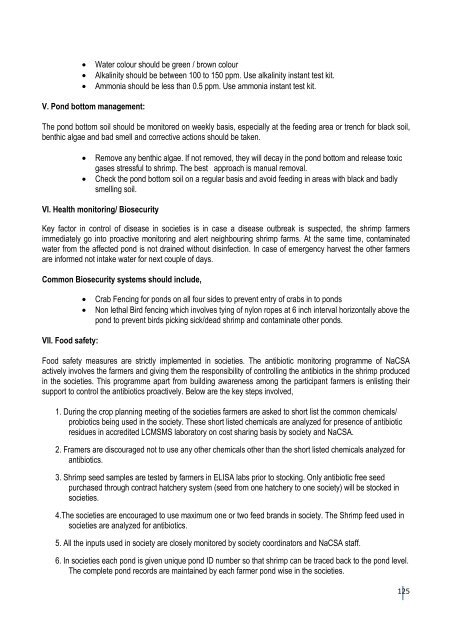Training of Trainers - Library - Network of Aquaculture Centres in ...
Training of Trainers - Library - Network of Aquaculture Centres in ...
Training of Trainers - Library - Network of Aquaculture Centres in ...
- No tags were found...
Create successful ePaper yourself
Turn your PDF publications into a flip-book with our unique Google optimized e-Paper software.
• Water colour should be green / brown colour• Alkal<strong>in</strong>ity should be between 100 to 150 ppm. Use alkal<strong>in</strong>ity <strong>in</strong>stant test kit.• Ammonia should be less than 0.5 ppm. Use ammonia <strong>in</strong>stant test kit.V. Pond bottom management:The pond bottom soil should be monitored on weekly basis, especially at the feed<strong>in</strong>g area or trench for black soil,benthic algae and bad smell and corrective actions should be taken.• Remove any benthic algae. If not removed, they will decay <strong>in</strong> the pond bottom and release toxicgases stressful to shrimp. The best approach is manual removal.• Check the pond bottom soil on a regular basis and avoid feed<strong>in</strong>g <strong>in</strong> areas with black and badlysmell<strong>in</strong>g soil.VI. Health monitor<strong>in</strong>g/ BiosecurityKey factor <strong>in</strong> control <strong>of</strong> disease <strong>in</strong> societies is <strong>in</strong> case a disease outbreak is suspected, the shrimp farmersimmediately go <strong>in</strong>to proactive monitor<strong>in</strong>g and alert neighbour<strong>in</strong>g shrimp farms. At the same time, contam<strong>in</strong>atedwater from the affected pond is not dra<strong>in</strong>ed without dis<strong>in</strong>fection. In case <strong>of</strong> emergency harvest the other farmersare <strong>in</strong>formed not <strong>in</strong>take water for next couple <strong>of</strong> days.Common Biosecurity systems should <strong>in</strong>clude,VII. Food safety:• Crab Fenc<strong>in</strong>g for ponds on all four sides to prevent entry <strong>of</strong> crabs <strong>in</strong> to ponds• Non lethal Bird fenc<strong>in</strong>g which <strong>in</strong>volves ty<strong>in</strong>g <strong>of</strong> nylon ropes at 6 <strong>in</strong>ch <strong>in</strong>terval horizontally above thepond to prevent birds pick<strong>in</strong>g sick/dead shrimp and contam<strong>in</strong>ate other ponds.Food safety measures are strictly implemented <strong>in</strong> societies. The antibiotic monitor<strong>in</strong>g programme <strong>of</strong> NaCSAactively <strong>in</strong>volves the farmers and giv<strong>in</strong>g them the responsibility <strong>of</strong> controll<strong>in</strong>g the antibiotics <strong>in</strong> the shrimp produced<strong>in</strong> the societies. This programme apart from build<strong>in</strong>g awareness among the participant farmers is enlist<strong>in</strong>g theirsupport to control the antibiotics proactively. Below are the key steps <strong>in</strong>volved,1. Dur<strong>in</strong>g the crop plann<strong>in</strong>g meet<strong>in</strong>g <strong>of</strong> the societies farmers are asked to short list the common chemicals/probiotics be<strong>in</strong>g used <strong>in</strong> the society. These short listed chemicals are analyzed for presence <strong>of</strong> antibioticresidues <strong>in</strong> accredited LCMSMS laboratory on cost shar<strong>in</strong>g basis by society and NaCSA.2. Framers are discouraged not to use any other chemicals other than the short listed chemicals analyzed forantibiotics.3. Shrimp seed samples are tested by farmers <strong>in</strong> ELISA labs prior to stock<strong>in</strong>g. Only antibiotic free seedpurchased through contract hatchery system (seed from one hatchery to one society) will be stocked <strong>in</strong>societies.4.The societies are encouraged to use maximum one or two feed brands <strong>in</strong> society. The Shrimp feed used <strong>in</strong>societies are analyzed for antibiotics.5. All the <strong>in</strong>puts used <strong>in</strong> society are closely monitored by society coord<strong>in</strong>ators and NaCSA staff.6. In societies each pond is given unique pond ID number so that shrimp can be traced back to the pond level.The complete pond records are ma<strong>in</strong>ta<strong>in</strong>ed by each farmer pond wise <strong>in</strong> the societies.125
















